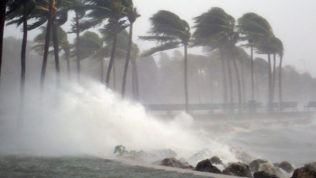Just as you prepare your home for severe weather, consider taking steps to prevent damage to your valuable articles and collections.
BEFORE THE STORM
- Prepare your home by adding protective hurricane shutters, hurricane glass windows and roof hurricane clips. Avoid taping windows which can increase potential damage to your property and increase the risk of harm to yourselves and others.
- Do not store fine art or furniture in your basement or attic.
- Consider installing a fortified or waterproof storm closet (custom-made or purchased) to store your collections.
- Prepare and maintain a fine art inventory file with images of each work, name of artist or maker, title, dimensions, media and year. Include invoices for each item. Protect your documents by securing important papers in water- and fireproof safes or storage boxes. In addition, keep a copy of all documentation at a separate, secure location. Consider also keeping a digital copy of your records.
- Maintain a list of emergency phone numbers including your insurance agent, insurance company (note your policy number), conservators, art storage facility, art transport company and local freeze dry facilities. Also include the details for an emergency generator and fuel facility, a hurricane or disaster recovery company (to pump out water, for example) and a contractor to do emergency repairs. Periodically check the numbers to see if they are still valid. Remember that cell phone towers are sometimes inactive after large storms. Store these numbers in your cell phone contacts but keep hard copies of the list with your important papers and with your insurance agent; keep another in your emergency kit.
- Consider a hurricane evacuation plan for your art collection. Contact local art storage facilities that could potentially provide secured storage space before the tropical storm or hurricane hits. In the absence of a hurricane evacuation plan, install a climate-controlled HVAC system with a backup generator to protect against rising humidity that can damage artwork.
AS HURRICANE WARNINGS BEGIN
- Make preliminary contact with service providers for generators, freeze-drying facilities, art packers and art transport companies. Contact your insurance agent with alternative emergency contact information.
- Determine which fine art and furniture can be transported to a warehouse with power generator and climate control. Notify your insurance agent in advance of removing works to ensure proper coverage in the new location.
- If works of art are left hanging on the walls, be sure all hanging devices are secure. Remember that wet plaster lacks structural integrity, and works hung on plaster walls could fall. Glass on framed works can be taped to prevent shattering. Plexiglas should not be taped.
- Move objects away from windows to a storm closet or to a water resistant area of your home. Elevate works at least 6 inches from the floor with blocks of wood or place them on shelves. Do not stack works on top of each other; place them next to each other. If your storage area does not have racks, separate works with cardboard larger than the size of the frame. Protective crates can also be used to store multiple small paintings, works on paper and small objects. Cases should be waterproof and elevated.
- If possible, bring outdoor sculptures inside, secure and wrap them in plastic sheeting. Sculptures left outside can be wrapped in burlap or blankets tied with rope to protect from flying sand or objects. Remove outdoor furniture that could become flying projectiles. If you are not able to bring outdoor furniture inside, stack pieces and tie them together and secure them to a static object.
- If your home is in a flood zone, ensure the generator is elevated at least to – and preferably above – the base flood elevation for the area. Include a waterproof instant camera in your supplies to document any damage in case your cell phone lacks service after a storm
AFTER THE STORM
- Photograph your rooms and document any damage to works of art.
- Use fans and dehumidifiers to recirculate air once power is restored.
- Furniture is particularly vulnerable when flooding occurs. Decorative wood elements may become loose or detached. Check for loose, damaged or deteriorating wood. Arrange to have these pieces of furniture treated by a conservator as soon as possible.
- If objects are wet, gently blot off excess moisture with towels or blotting paper. Remove wet backings, mats, and frames.
- Remove any remaining wrapping on outdoor objects, and rinse the sculpture with clean water.
- Move works to an air-conditioned area. If there is no power, move works to a lighted area with air movement. Mold develops quickly in high humidity, high temperature and darkness but cannot survive in well-ventilated conditions.
- In coastal areas, a fine layer of salt may have been deposited on works during the storm. Carefully dust secure works with a soft brush. Wipe metal objects with a soft cloth. Consider using the services of a professional conservator.
- Contact a conservator as soon as possible; early treatment can reduce damage to paintings, sculpture and works on paper.
- In the event of a loss, contact your agent or insurance company immediately.
A loss prevention plan stressing rapid intervention will help you mitigate damages to the collection you have so passionately built. Preparation is the key to damage control.
This loss control information is advisory only. The author assumes no responsibility for management or control of loss control activities. Not all exposures are identified in this article.

